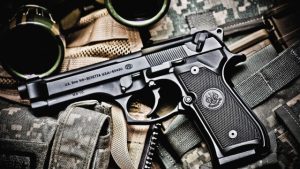Firearms have long been a source of fascination, controversy, and even fear across the globe. From ancient weapons crafted for war to the sleek and powerful firearms of today, these tools have played a significant role in shaping history and society. Whether viewed as a means of protection, a symbol of power, or a deadly force to be reckoned with, firearms continue to hold a prominent place in our collective consciousness. In this article, we will delve into the world of firearms, exploring the intricacies of ammunition, the evolution of these weapons, and their impact on our world. Join us as we take a deep dive into the locked and loaded world of firearms.
Ammunition Types
There are several different types of ammunition commonly used in firearms. Each type is designed for specific purposes and has unique characteristics that affect its performance. In this section, we will explore some of the key ammunition types used in firearms.
Firstly, we have the most widely used ammunition type: full metal jacket (FMJ). FMJ rounds are typically used for target practice, as they offer good accuracy and reliability. These rounds consist of a lead core encased in a harder metal, such as copper or steel. The outer metal jacket helps prevent barrel fouling and promotes smoother feeding in semi-automatic firearms.
Next, we have hollow point ammunition. Hollow point rounds are designed for self-defense and law enforcement purposes. These rounds feature a hollow cavity at the tip which expands upon impact, causing the bullet to deform and create a larger wound channel. This expansion limits over-penetration, making hollow point ammunition safer in civilian areas.
Another important ammunition type is armor-piercing rounds. These specialized rounds are designed to penetrate armor, such as bulletproof vests or vehicle armor. Armor-piercing rounds often feature a steel or tungsten core, which allows them to retain their shape and penetrate hardened targets.
In conclusion, understanding the different types of ammunition is crucial for firearm owners and enthusiasts. Whether you’re looking for accuracy in target shooting, self-defense capabilities, or specialized penetration power, knowing which ammunition type suits your needs is essential. This knowledge ensures the safe and effective use of firearms while maximizing their intended purpose.
Firearms Categories
When diving into the world of firearms, it’s crucial to understand the various categories these weapons fall under. This knowledge not only allows enthusiasts and newcomers alike to distinguish between different types of firearms, but it also helps to comprehend their unique characteristics and uses.
Handguns
Handguns are firearms designed to be held and operated with one hand. This category encompasses pistols and revolvers. Pistols, often semi-automatic, utilize a feeding mechanism that allows for multiple rounds of ammunition to be loaded into a magazine. These rounds are then chambered automatically as the trigger is pulled. On the other hand, revolvers are typically mechanically simpler, utilizing a rotating cylinder that houses individual ammunition chambers. When the trigger is pulled, the cylinder rotates, aligning a fresh round with the barrel.
Rifles
Ammunition
Rifles, in contrast to handguns, are designed to be fired from the shoulder using both hands. This category includes bolt-action, semi-automatic, and fully automatic rifles. Bolt-action rifles require manual manipulation of the bolt after each shot to chamber a new round, whereas semi-automatic rifles automatically load and chamber a fresh round with each squeeze of the trigger. Fully automatic rifles, often referred to as machine guns, have the capability to continuously fire rounds as long as the trigger remains pulled.
Shotguns
Shotguns are firearms that are specifically designed to discharge a multitude of small pellets or a single solid projectile, known as a slug, with each shot. These firearms have a smooth bore and are typically used for hunting, self-defense, and sport shooting. Shotguns come in various types, including pump-action, break action, semi-automatic, and bolt-action, each with its own unique loading and firing mechanisms.
Understanding the different categories of firearms provides a foundation for further exploration into their functionality, applications, and regulations. By delving into the intricacies of handguns, rifles, and shotguns, we can better appreciate the diversity and complexity of the firearms world.
Safety and Regulations
Firearms safety is of utmost importance to ensure the well-being of both the user and those around them. Stringent regulations exist to minimize the risks associated with firearms use. These regulations encompass various aspects, including proper storage, training, and licensing.
One crucial aspect of firearms safety is understanding and implementing proper storage practices. Owning a firearm comes with the responsibility of securely storing it when not in use. This helps prevent unauthorized access, particularly by minors, and reduces the likelihood of accidents or misuse. Many jurisdictions specify specific requirements for gun safes or lockboxes to ensure firearms are stored in a secure manner.
Firearms training plays a significant role in promoting safety. It is essential for individuals to receive proper education and training on how to handle firearms safely, including how to load and unload them, store them securely, and operate them correctly. Training courses may also cover topics such as maintenance and troubleshooting to ensure the proper functioning of firearms.
To regulate the ownership and use of firearms, licensing systems are often in place. These systems require individuals to meet specific criteria before obtaining a firearms license. These criteria may include age restrictions, background checks, and mental health assessments, depending on the jurisdiction. By implementing licensing procedures, authorities aim to screen potential gun owners and ensure that firearms are only possessed by responsible and qualified individuals.
By adhering to safety guidelines and regulations, individuals can enjoy the responsible use of firearms while minimizing risks and promoting overall community safety. It is crucial for gun owners to remain compliant with their jurisdiction’s laws and regulations, continuously educate themselves on firearms safety, and prioritize the well-being of themselves and others.







Recent Comments